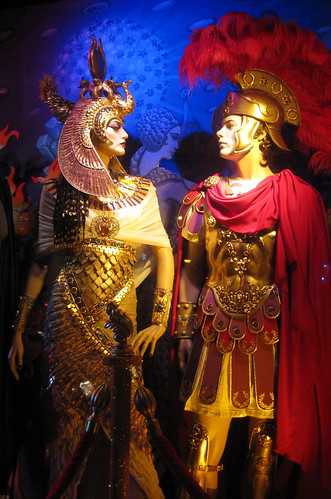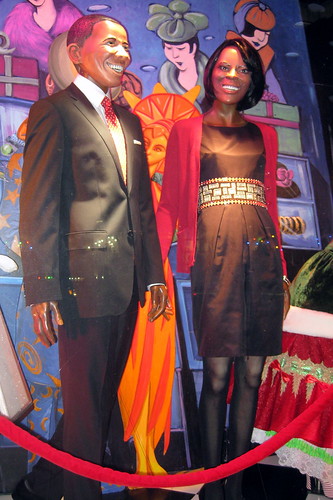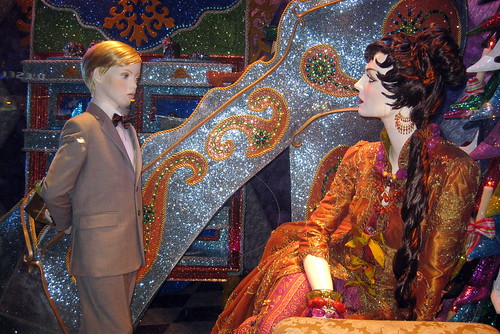NYC - Bloomingdale's 2009 Holiday Window - Dynamic Duos - Batman and Robin
Image by wallyg
Dynamic Duos
Some perfect pairs were meant to go together
One for you and one for me, forever and ever.
Bloomingdale's 2009 Holiday window display.
Bloomingdale's, a chain of upscale American department stores owned by Macy's, Inc., has 36 stores nationwide, with annual sales of .9 billion dollars. Bloomingdale's started in 1861 when brothers Joseph and Lyman Bloomingdale started selling hoop-skirts in their Ladies Notions' Shop on Manhattan's Lower East Side. In 1872, Bloomingdale's expanded and opened their East Side Bazaar, a harbinger of the modern "department store."
In 1886, it moved to 59th Street and Lexington Avenue, still their flagship store, anticipating and capitalizing on the northern movement of New York's upper and middle classes. By 1929, Bloomingdale's covered an entire city block. Two years later, the glamorous Art Deco edifice that still graces Lexington Avenue was completed. In 1949, Bloomingdale's began its real expansion, opening its first satellite store in Fresh Meadows, Queens and by 1959, Bloomingdale's had created a complete circle of stores around the flagship, in New Jersey, Westchester County and Long Island. This dramatic growth continued in the 70's and 80's with the opening of stores in the Northeast, Florida, and Chicago. Bloomingdale's was on its way to becoming a true national entity. That vision culminated in November 1996 with the addition of its first four stores in California, the most ambitious expansion in the company's history.
From the beginning, the Bloomingdale's brothers catered to America's love of international goods, and by the 1880's, their European selection was dazzling. A buying office in Paris in 1886 was the beginning of a network that now spans the globe. The 1960's brought promotions resulting from Bloomingdale's fascination with the foreign market: the first was a small affair called "Casa Bella" featuring merchandise for the home from Italy. Over the next thirty years, the promotions took on a grand scale - including unique merchandise and cultural exhibits that would touch every department in Bloomingdale's. Major transformation of the Bloomingdale's image came in the 1960's and 70's. The promotions were so exciting that the term "Retailing as Theater" was coined to describe Bloomingdale's "happenings." It was the era of pet rocks and glacial ice cubes, of visits by movie stars and royalty, from Elizabeth Taylor to Queen Elizabeth II.
The new direction in merchandising was both to seek and to create. Buyers covered the globe to find exclusive, one-of-a-kind items. When they couldn't find what they wanted, they had it made. In fashion, Bloomingdale's launched new designers and created boutiques for already-famous names. Among the discoveries: Ralph Lauren, Perry Ellis and Norma Kamali - and for the first time in America: Sonia Rykiel, Kenzo and Fendi ready-to-wear. Designers opening their first in-store boutiques at Bloomingdale's include Yves St. Laurent, Calvin Klein, Claude Montana and Thierry Mugler.
In 1961, Bloomingdale's made retail history in yet another area by introducing the first designer shopping bag. Artist Joseph Kinigstein was commissioned to create a bag for the "Esprit de France" promotion. Rather than doing the obvious - ladylike flowers in pastel colors - he reproduced antique French tarot cards in bold red, black and white. Most daring of all, the bag omitted the store name. Even so, it was unmistakably Bloomingdale's, and the collector's shopping bag was launched. Since then, Bloomingdale's bags have been created by both famous and fledgling artists, architects and ad designers. Their designs have been featured in art museums all over the world.
In 1971 "model rooms", a highlight of Bloomingdale's since 1947, gained worldwide attention. "The Cave," an intricate multi-level frame sprayed entirely in white polyurethane, was a spectacular example of the lengths to which Bloomingdale's would go to make a statement of style. Over the years, the model rooms have been showcases for the talents of everyone from architect Frank Gehry to filmmaker Federico Fellini.
During the 1970's, Bloomingdale's was a favorite stop of the international avant-garde, epitomized locally by the "Young East Sider" who lived right in the neighborhood. In 1973 the store wanted to stamp the Bloomingdale's name on panties to launch an intimate apparel promotion, they chose the company nickname as a nod to the young, trendy crowd, and the "Bloomie's" logo was born. Soon, New Yorkers were affectionately referring to the city's second most popular tourist attraction after the Statue of Liberty as "Bloomie's" and the hottest souvenir in town was anything emblazoned with "Bloomie's".
NYC - Bloomingdale's 2009 Holiday Window - Dynamic Duos - Mark Antony and Cleopatra
Image by wallyg
Dynamic Duos
Some perfect pairs were meant to go together
One for you and one for me, forever and ever.
Bloomingdale's 2009 Holiday window display.
Bloomingdale's, a chain of upscale American department stores owned by Macy's, Inc., has 36 stores nationwide, with annual sales of .9 billion dollars. Bloomingdale's started in 1861 when brothers Joseph and Lyman Bloomingdale started selling hoop-skirts in their Ladies Notions' Shop on Manhattan's Lower East Side. In 1872, Bloomingdale's expanded and opened their East Side Bazaar, a harbinger of the modern "department store."
In 1886, it moved to 59th Street and Lexington Avenue, still their flagship store, anticipating and capitalizing on the northern movement of New York's upper and middle classes. By 1929, Bloomingdale's covered an entire city block. Two years later, the glamorous Art Deco edifice that still graces Lexington Avenue was completed. In 1949, Bloomingdale's began its real expansion, opening its first satellite store in Fresh Meadows, Queens and by 1959, Bloomingdale's had created a complete circle of stores around the flagship, in New Jersey, Westchester County and Long Island. This dramatic growth continued in the 70's and 80's with the opening of stores in the Northeast, Florida, and Chicago. Bloomingdale's was on its way to becoming a true national entity. That vision culminated in November 1996 with the addition of its first four stores in California, the most ambitious expansion in the company's history.
From the beginning, the Bloomingdale's brothers catered to America's love of international goods, and by the 1880's, their European selection was dazzling. A buying office in Paris in 1886 was the beginning of a network that now spans the globe. The 1960's brought promotions resulting from Bloomingdale's fascination with the foreign market: the first was a small affair called "Casa Bella" featuring merchandise for the home from Italy. Over the next thirty years, the promotions took on a grand scale - including unique merchandise and cultural exhibits that would touch every department in Bloomingdale's. Major transformation of the Bloomingdale's image came in the 1960's and 70's. The promotions were so exciting that the term "Retailing as Theater" was coined to describe Bloomingdale's "happenings." It was the era of pet rocks and glacial ice cubes, of visits by movie stars and royalty, from Elizabeth Taylor to Queen Elizabeth II.
The new direction in merchandising was both to seek and to create. Buyers covered the globe to find exclusive, one-of-a-kind items. When they couldn't find what they wanted, they had it made. In fashion, Bloomingdale's launched new designers and created boutiques for already-famous names. Among the discoveries: Ralph Lauren, Perry Ellis and Norma Kamali - and for the first time in America: Sonia Rykiel, Kenzo and Fendi ready-to-wear. Designers opening their first in-store boutiques at Bloomingdale's include Yves St. Laurent, Calvin Klein, Claude Montana and Thierry Mugler.
In 1961, Bloomingdale's made retail history in yet another area by introducing the first designer shopping bag. Artist Joseph Kinigstein was commissioned to create a bag for the "Esprit de France" promotion. Rather than doing the obvious - ladylike flowers in pastel colors - he reproduced antique French tarot cards in bold red, black and white. Most daring of all, the bag omitted the store name. Even so, it was unmistakably Bloomingdale's, and the collector's shopping bag was launched. Since then, Bloomingdale's bags have been created by both famous and fledgling artists, architects and ad designers. Their designs have been featured in art museums all over the world.
In 1971 "model rooms", a highlight of Bloomingdale's since 1947, gained worldwide attention. "The Cave," an intricate multi-level frame sprayed entirely in white polyurethane, was a spectacular example of the lengths to which Bloomingdale's would go to make a statement of style. Over the years, the model rooms have been showcases for the talents of everyone from architect Frank Gehry to filmmaker Federico Fellini.
During the 1970's, Bloomingdale's was a favorite stop of the international avant-garde, epitomized locally by the "Young East Sider" who lived right in the neighborhood. In 1973 the store wanted to stamp the Bloomingdale's name on panties to launch an intimate apparel promotion, they chose the company nickname as a nod to the young, trendy crowd, and the "Bloomie's" logo was born. Soon, New Yorkers were affectionately referring to the city's second most popular tourist attraction after the Statue of Liberty as "Bloomie's" and the hottest souvenir in town was anything emblazoned with "Bloomie's".
NYC: Bloomingdale's 2009 Holiday Window - Dynamic Duos - The Obamas
Image by wallyg
Dynamic Duos
Some perfect pairs were meant to go together
One for you and one for me, forever and ever.
Bloomingdale's 2009 Holiday window display.
Bloomingdale's, a chain of upscale American department stores owned by Macy's, Inc., has 36 stores nationwide, with annual sales of .9 billion dollars. Bloomingdale's started in 1861 when brothers Joseph and Lyman Bloomingdale started selling hoop-skirts in their Ladies Notions' Shop on Manhattan's Lower East Side. In 1872, Bloomingdale's expanded and opened their East Side Bazaar, a harbinger of the modern "department store."
In 1886, it moved to 59th Street and Lexington Avenue, still their flagship store, anticipating and capitalizing on the northern movement of New York's upper and middle classes. By 1929, Bloomingdale's covered an entire city block. Two years later, the glamorous Art Deco edifice that still graces Lexington Avenue was completed. In 1949, Bloomingdale's began its real expansion, opening its first satellite store in Fresh Meadows, Queens and by 1959, Bloomingdale's had created a complete circle of stores around the flagship, in New Jersey, Westchester County and Long Island. This dramatic growth continued in the 70's and 80's with the opening of stores in the Northeast, Florida, and Chicago. Bloomingdale's was on its way to becoming a true national entity. That vision culminated in November 1996 with the addition of its first four stores in California, the most ambitious expansion in the company's history.
From the beginning, the Bloomingdale's brothers catered to America's love of international goods, and by the 1880's, their European selection was dazzling. A buying office in Paris in 1886 was the beginning of a network that now spans the globe. The 1960's brought promotions resulting from Bloomingdale's fascination with the foreign market: the first was a small affair called "Casa Bella" featuring merchandise for the home from Italy. Over the next thirty years, the promotions took on a grand scale - including unique merchandise and cultural exhibits that would touch every department in Bloomingdale's. Major transformation of the Bloomingdale's image came in the 1960's and 70's. The promotions were so exciting that the term "Retailing as Theater" was coined to describe Bloomingdale's "happenings." It was the era of pet rocks and glacial ice cubes, of visits by movie stars and royalty, from Elizabeth Taylor to Queen Elizabeth II.
The new direction in merchandising was both to seek and to create. Buyers covered the globe to find exclusive, one-of-a-kind items. When they couldn't find what they wanted, they had it made. In fashion, Bloomingdale's launched new designers and created boutiques for already-famous names. Among the discoveries: Ralph Lauren, Perry Ellis and Norma Kamali - and for the first time in America: Sonia Rykiel, Kenzo and Fendi ready-to-wear. Designers opening their first in-store boutiques at Bloomingdale's include Yves St. Laurent, Calvin Klein, Claude Montana and Thierry Mugler.
In 1961, Bloomingdale's made retail history in yet another area by introducing the first designer shopping bag. Artist Joseph Kinigstein was commissioned to create a bag for the "Esprit de France" promotion. Rather than doing the obvious - ladylike flowers in pastel colors - he reproduced antique French tarot cards in bold red, black and white. Most daring of all, the bag omitted the store name. Even so, it was unmistakably Bloomingdale's, and the collector's shopping bag was launched. Since then, Bloomingdale's bags have been created by both famous and fledgling artists, architects and ad designers. Their designs have been featured in art museums all over the world.
In 1971 "model rooms", a highlight of Bloomingdale's since 1947, gained worldwide attention. "The Cave," an intricate multi-level frame sprayed entirely in white polyurethane, was a spectacular example of the lengths to which Bloomingdale's would go to make a statement of style. Over the years, the model rooms have been showcases for the talents of everyone from architect Frank Gehry to filmmaker Federico Fellini.
During the 1970's, Bloomingdale's was a favorite stop of the international avant-garde, epitomized locally by the "Young East Sider" who lived right in the neighborhood. In 1973 the store wanted to stamp the Bloomingdale's name on panties to launch an intimate apparel promotion, they chose the company nickname as a nod to the young, trendy crowd, and the "Bloomie's" logo was born. Soon, New Yorkers were affectionately referring to the city's second most popular tourist attraction after the Statue of Liberty as "Bloomie's" and the hottest souvenir in town was anything emblazoned with "Bloomie's".
NYC: Bloomingdale's 2009 Holiday Window - Treasures Forever
Image by wallyg
Treasures Forever
She loves beauty and style, and new shoes too!
But, most of all, her greatest treasure is YOU!
Bloomingdale's 2009 Holiday window display.
Bloomingdale's, a chain of upscale American department stores owned by Macy's, Inc., has 36 stores nationwide, with annual sales of .9 billion dollars. Bloomingdale's started in 1861 when brothers Joseph and Lyman Bloomingdale started selling hoop-skirts in their Ladies Notions' Shop on Manhattan's Lower East Side. In 1872, Bloomingdale's expanded and opened their East Side Bazaar, a harbinger of the modern "department store."
In 1886, it moved to 59th Street and Lexington Avenue, still their flagship store, anticipating and capitalizing on the northern movement of New York's upper and middle classes. By 1929, Bloomingdale's covered an entire city block. Two years later, the glamorous Art Deco edifice that still graces Lexington Avenue was completed. In 1949, Bloomingdale's began its real expansion, opening its first satellite store in Fresh Meadows, Queens and by 1959, Bloomingdale's had created a complete circle of stores around the flagship, in New Jersey, Westchester County and Long Island. This dramatic growth continued in the 70's and 80's with the opening of stores in the Northeast, Florida, and Chicago. Bloomingdale's was on its way to becoming a true national entity. That vision culminated in November 1996 with the addition of its first four stores in California, the most ambitious expansion in the company's history.
From the beginning, the Bloomingdale's brothers catered to America's love of international goods, and by the 1880's, their European selection was dazzling. A buying office in Paris in 1886 was the beginning of a network that now spans the globe. The 1960's brought promotions resulting from Bloomingdale's fascination with the foreign market: the first was a small affair called "Casa Bella" featuring merchandise for the home from Italy. Over the next thirty years, the promotions took on a grand scale - including unique merchandise and cultural exhibits that would touch every department in Bloomingdale's. Major transformation of the Bloomingdale's image came in the 1960's and 70's. The promotions were so exciting that the term "Retailing as Theater" was coined to describe Bloomingdale's "happenings." It was the era of pet rocks and glacial ice cubes, of visits by movie stars and royalty, from Elizabeth Taylor to Queen Elizabeth II.
The new direction in merchandising was both to seek and to create. Buyers covered the globe to find exclusive, one-of-a-kind items. When they couldn't find what they wanted, they had it made. In fashion, Bloomingdale's launched new designers and created boutiques for already-famous names. Among the discoveries: Ralph Lauren, Perry Ellis and Norma Kamali - and for the first time in America: Sonia Rykiel, Kenzo and Fendi ready-to-wear. Designers opening their first in-store boutiques at Bloomingdale's include Yves St. Laurent, Calvin Klein, Claude Montana and Thierry Mugler.
In 1961, Bloomingdale's made retail history in yet another area by introducing the first designer shopping bag. Artist Joseph Kinigstein was commissioned to create a bag for the "Esprit de France" promotion. Rather than doing the obvious - ladylike flowers in pastel colors - he reproduced antique French tarot cards in bold red, black and white. Most daring of all, the bag omitted the store name. Even so, it was unmistakably Bloomingdale's, and the collector's shopping bag was launched. Since then, Bloomingdale's bags have been created by both famous and fledgling artists, architects and ad designers. Their designs have been featured in art museums all over the world.
In 1971 "model rooms", a highlight of Bloomingdale's since 1947, gained worldwide attention. "The Cave," an intricate multi-level frame sprayed entirely in white polyurethane, was a spectacular example of the lengths to which Bloomingdale's would go to make a statement of style. Over the years, the model rooms have been showcases for the talents of everyone from architect Frank Gehry to filmmaker Federico Fellini.
During the 1970's, Bloomingdale's was a favorite stop of the international avant-garde, epitomized locally by the "Young East Sider" who lived right in the neighborhood. In 1973 the store wanted to stamp the Bloomingdale's name on panties to launch an intimate apparel promotion, they chose the company nickname as a nod to the young, trendy crowd, and the "Bloomie's" logo was born. Soon, New Yorkers were affectionately referring to the city's second most popular tourist attraction after the Statue of Liberty as "Bloomie's" and the hottest souvenir in town was anything emblazoned with "Bloomie's".
Incoming President Loh and Mrs. Loh To Help Students Stay in School
Image by University of Maryland Press Releases
(Photo caption above: Dr. Wallace and Barbara Loh)
COLLEGE PARK, Md. -- Incoming University of Maryland President, Wallace D. Loh, who officially takes the helm on November 1, and his wife, Barbara, recently pledged 0,000 to help need-based undergraduate and graduate students stay in school.
The gift will be spread over four years. Of the first year's gift, ,000 will support Keep Me Maryland, the emergency student fund. Dr. and Mrs. Loh have also become Lifetime Members of the University of Maryland Alumni Association with a gift of ,000.
During the 2008-09 academic year, as the economic recession hit, many students and their families faced unanticipated financial challenges. The University's Office of Student Financial Aid received more than 900 appeals for emergency aid from students struggling to stay in school. During the 2009-10 academic year, emergency aid requests exceeded 1,500, and it is expected that such requests during this year will continue to rise. Typically, a relatively modest award, between 0 and 00, can make a difference between a student dropping out and remaining in school.
According to Sarah Bauder, Director, Office of Financial Aid, Maryland families are really feeling the strain of the economy. Parents were and are losing jobs. Appeals for financial aid continue to rise. "Students are at risk of putting a college education aside to ease their family's financial aid burden," she said.
In creating Keep Me Maryland (KMM), the University of Maryland made an appeal across the campus community and among alumni and friends for scholarship and student assistance beyond other campaigns. KMM became part of the university's billion capital campaign, Great Expectations: The Campaign for Maryland, one-third of which is targeted for student support.
To date, many have joined KMM, raising more than 0,000 to help Maryland students stay in school. For example, current students, through their own initiative, created a card-swipe project in campus dining halls last year that raised more than ,000 from 1,100 students. Students already have plans for another card-swipe drive in the dining halls in November.
Keep Me Maryland
Loh arrived alone in the United States from Peru at age 16 with 0 and, he says, "an unwavering faith in the promise of this country."
"America is still the 'land of opportunity' for many just like me. I could not have obtained an education had it not been for support and encouragement of too many people to name," said Loh. "Barbara and I want to do something to help today's talented Maryland students pursue their dreams."
According to Brodie Remington, Vice President for University Relations, Dr. and Mrs. Loh's gift to KMM has been matched by others, with donors Murray and Suzanne Valenstein in the lead, to establish a ,000 fund. This will be used to match dollar-for-dollar gifts from students and young alumni, and hence, the total raised will reach or exceed 0,000.
"It's very exciting to see the Lohs make such a personal and direct commitment to help our students, even before Dr. Loh officially takes office. Their commitment to students is very clear, and their generous gift is already inspiring support from our students and alumni," said Remington.
No comments:
Post a Comment